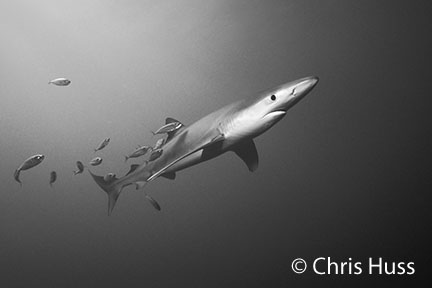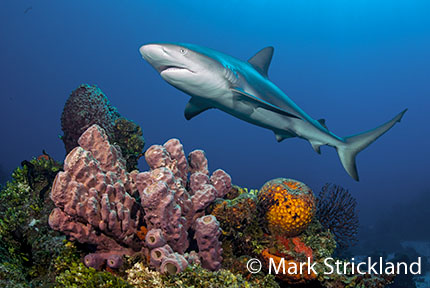
Photo credit: Chris Huss
It’s time to talk sharks!
Sharks are very misunderstood creatures. Thanks to the movie Jaws and its haunting theme song, very few people are able to see sharks clearly anymore. Sharks are just really cool fish trying to survive in the big blue ocean and in the process have had some nasty encounters with humans. And the vast majority of these encounters end very badly for sharks.
Millions of sharks die every year to satiate the demand for shark fin soup, a tradition popular in China. The amount of sharks being caught and killed for their fins is completely unsustainable. This combined with the enduring legacy of Jaws means sharks have a serious PR hurdle to overcome. But what’s a person to do?
The answer for two underwater photographers was simple: Showcase sharks in all their natural beauty and glory to help people understand and appreciate these remarkable fish and realize that they’re not that scary after all and should be protected.
I was lucky enough to meet both photographers, Chris Huss and Mark Strickland, at their G2 Gallery opening in Venice, California. The underwater photographs are amazing and give sharks the proper respect they deserve. The exhibit is timed to coincide with the Convention on International Trade in Endangered Species of Wild Flora & Fauna (CITES), where listing sharks as endangered species will be considered in March 2013.
Chris Huss and Mark Strickland are incredibly talented and passionate about their mission to save sharks. Each of them has been taking shark photographs for close to 30 years and they’ve witnessed changes to shark populations firsthand. I ended up getting into a discussion with Chris about shifting baselines. It’s a concept commonly thrown around in ocean circles to gauge the changes taking place to marine life. (Wikipedia actually has a really good explanation on shifting baselines for those interested.)
For the most part, the concept of shifting baselines applies to fisheries management and how to manage fish and marine life populations compared to historical data available. Do you enforce regulations based on fish populations 30 years ago or based on the true normal, which is what fish populations were long before humans entered the scene?
The concept of shifting baselines is fascinating because as the ocean changes, the concept of what is normal changes with it. For example, in some of the areas Chris has dived repeatedly during the last 30 years he has watched shark populations decline drastically. Yet, today he’ll see other divers get so excited about seeing one or two sharks when in reality they should be seeing hundreds of sharks. But how do you get people to understand that?
“The shark in the black and white photo is a blue shark, once very common in deep ocean waters of Southern California and now they are very rare,” said Chris. “When I took that photo it was common to be able to see 20 to 30 at a time, now a diver is lucky if they see one in an entire day.”
Thankfully, Chris and Mark are trying to remind all of us what normal is when it comes to sharks. Help them help sharks by going to see their amazing photographs at the G2 Gallery in Venice, which are on display through March 3rd.
This is your chance to understand these fabulous fish and heal any misleading impressions you’ve received over the years from Hollywood. It’s time to protect sharks and list them as endangered before it’s too late.

Leave a Reply